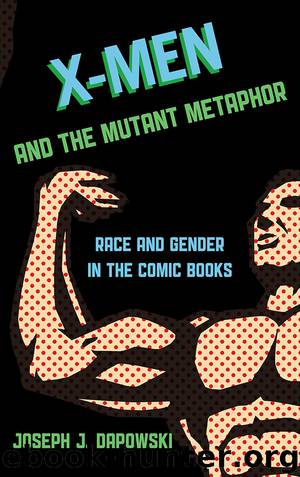X-Men and the Mutant Metaphor by Darowski Joseph J.;

Author:Darowski, Joseph J.; [Darowski, Joseph J.]
Language: eng
Format: epub
Publisher: Rowman & Littlefield Publishers
Published: 2014-10-14T16:00:00+00:00
Chapter Five
Broadening the Mutant Metaphor
The Uncanny X-Men #281 (Oct. 1991) to The Uncanny X-Men #393 (June 2001)
Creators and General Storyline
This period represents a significant change in the publication practices of Marvel concerning the X-Men franchise. Although several previous spin-off titles had been associated with the X-Men franchise, including Dazzler, New Mutants, X-Factor, Wolverine, and Excalibur, those series had different focuses than did The Uncanny X-Men. Dazzler and Wolverine featured the adventures of a single protagonist, New Mutants was about a young new generation of mutants being trained in their powers, and X-Factor was initially envisioned as a chance to reunite the original X-Men. Excalibur featured a team of mutants based in Britain and employed several of Marvel’s British characters as well as popular members of The Uncanny X-Men who were being written out of that series. These titles were kept largely separate from one another. The team title that interacted with The Uncanny X-Men most often was New Mutants because both groups were based out of Xavier’s mansion.
In 1991 Marvel published X-Men #1 (Oct. 1991), which was the highest-selling comic book in history. This new series was to be a second “core” X-Men title. All the previous titles had been ancillary to the adventures of the core team called the X-Men, but X-Men and The Uncanny X-Men would feature two teams of X-Men that used the same base of operations. The “Gold Team” would be in X-Men, and the “Blue Team” would be in The Uncanny X-Men. Originally, the plan was that the two teams would be completely separate, but quickly crossovers and guest stars were shared between the two titles. At this same time, New Mutants changed its name to X-Force to more closely be associated with the other X-titles and also to recognize the new direction that title was taking. No longer would that team be students; they were now soldiers led by a mysterious mutant from the future named Cable.
As previously addressed, Chris Claremont ceased writing The Uncanny X-Men due to creative and editorial conflicts. Jim Lee, a popular artist, wanted to take the X-Men in a direction Chris Claremont did not want to explore, and the editor gave preference to Lee. Following Claremont’s departure, Marvel brought John Byrne in to script Jim Lee’s plot outlines in hopes of connecting with the fan base that saw the Claremont-Byrne era as the height of X-Men success. Byrne would last only a few issues before frustrations caused him to quit. Unfortunately for Marvel, after a little more than a year Lee left Marvel Comics to found a new comic book company with six of the most popular artists of the time. Marvel alienated Claremont to appease Lee, who left shortly thereafter
Scott Lobdell replaced Byrne as the writer, and he had a long tenure before being replaced by Steven Seagle, then Terry Kavanagh, and eventually Chris Claremont. Almost a decade after leaving the title, and exactly one hundred issues after he left, Claremont would return to The Uncanny X-Men for a nine-issue run.
Download
This site does not store any files on its server. We only index and link to content provided by other sites. Please contact the content providers to delete copyright contents if any and email us, we'll remove relevant links or contents immediately.
4 3 2 1: A Novel by Paul Auster(12286)
The handmaid's tale by Margaret Atwood(7679)
Giovanni's Room by James Baldwin(7192)
Asking the Right Questions: A Guide to Critical Thinking by M. Neil Browne & Stuart M. Keeley(5639)
Big Magic: Creative Living Beyond Fear by Elizabeth Gilbert(5614)
Ego Is the Enemy by Ryan Holiday(5294)
The Body: A Guide for Occupants by Bill Bryson(4974)
On Writing A Memoir of the Craft by Stephen King(4863)
Ken Follett - World without end by Ken Follett(4645)
Adulting by Kelly Williams Brown(4487)
Bluets by Maggie Nelson(4474)
Eat That Frog! by Brian Tracy(4436)
Guilty Pleasures by Laurell K Hamilton(4360)
The Poetry of Pablo Neruda by Pablo Neruda(4040)
Alive: The Story of the Andes Survivors by Piers Paul Read(3969)
White Noise - A Novel by Don DeLillo(3954)
Fingerprints of the Gods by Graham Hancock(3942)
The Book of Joy by Dalai Lama(3901)
The Bookshop by Penelope Fitzgerald(3777)
